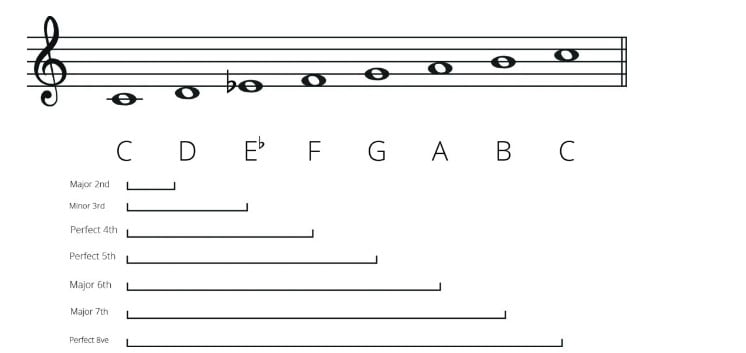What is the Melodic Minor Scale
Minor scales have a distinct sound from major scales due to their unique interval patterns. There are three types of minor scales: natural, harmonic, and melodic. A minor scale shares its key signature with the relative major scale. Understanding the relationships between different scales is crucial in music theory. In this blog post, we will focus on the melodic minor scale but first, we need to briefly discuss the natural and harmonic minor scales. To learn more about relative keys and their key signatures, check out our blog post.
The Natural Minor Scale
The natural minor scale is formed by starting on a different note of the major scale. Its tone and semitone pattern is: Tone, Semitone, Tone, Tone, Semitone, Tone, Tone.
For example, the E natural minor scale follows this pattern: E, F#, G, A, B, C, D, E.
It's worth noting that the E natural minor scale has an F#. E minor is the relative minor to G major. The natural minor scale is the same ascending and descending. It's a great starting point to learn about minor scales and understand the relationship between major and minor keys.

The Harmonic Minor Scale
The harmonic minor scale is similar to the major scale, but with one notable difference. To form the harmonic minor scale, we must raise the seventh note when ascending and descending.
The pattern of tones and semitones in a harmonic minor scale is as follows: Tone, Semitone, Tone, Tone, Semitone, Tone and a half, Semitone.
For instance, the E harmonic minor scale would follow this pattern: E, F#, G, A, B, C, D#, E. All harmonic minor scales have the same pattern

The Melodic Minor Scale
Melodic minor scales differ from both natural and harmonic minor scales. The ascending and descending forms of the melodic minor scale are different, unlike the other minor scales that are the same in both directions.
To create a melodic minor scale, you need to raise the sixth and seventh notes when ascending and lower them when descending. As a result, the ascending melodic minor scale is different from the descending scale.
The tone and semitone pattern for the ascending melodic minor scale is: Whole step, half step, Whole step, Whole step, Whole step, Whole step, half step.
For example, the ascending C melodic minor scale is C, D, Eb, F, G, A, B, C.

Now lets look at the descending melodic minor scale: C, Bb, Ab, G, F, Eb, D, C

The descending melodic minor scale is identical to the natural minor scale or its relative major scale starting on a different note.
Classical music theory recognizes the difference between the ascending and descending forms of melodic minor scales. However, in jazz theory, when we talk about the melodic minor scale, we refer to the ascending version of the scale.
The ascending melodic minor scale consists of the following intervals: Major 2nd, minor 3rd, Perfect fourth, Perfect fifth, Major sixth, Major seventh, and Perfect Octave.

Having a good understanding of intervals is essential as it enables you to transition smoothly between major and minor scales. If you need a refresher, we have a beginner's guide to intervals that you can check out. Knowing intervals also helps in constructing chords.
What is the purpose of using the melodic minor scale?
The melodic minor scale is primarily used in creating melodies. By raising the sixth and seventh notes, it produces a unique sound that can result in beautiful melodies. Many popular songs showcase the melodic minor scale, and you can listen to them to appreciate its effect.
Which chords or triads used to build a melodic minor scale?
The triad qualities that can be formed from a melodic minor scale are as follows:
- Chord i: minor
- Chord ii: minor
- Chord III: augmented
- Chord IV: Major
- Chord V: Major
- Chord vio: Diminished
- Chord viio: Diminished
For instance, if we take the C melodic minor scale, the resulting chords would be:
- Chord i: C, Eb, G
- Chord ii: D, F, A
- Chord III: Eb, G, B
- Chord IV: F, A, C
- Chord V: G, B, D
- Chord vio: A, C, Eb
- Chord viio: B, D, F

Knowing how to construct chords based on each scale degree is crucial in creating chord progressions for melodies composed in a melodic minor key. The use of the melodic minor scale can add complexity and interest to the music you write.
If you’re interested in learning more about music scales, chords, and musical theory, visit our Guitar tunio today








